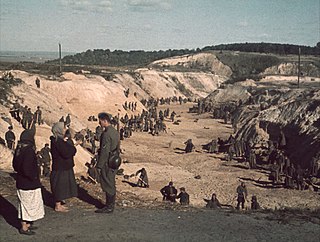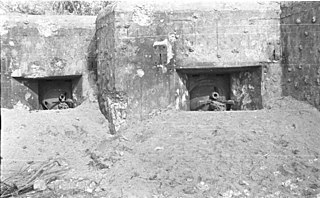 W
WBabi Yar is a ravine in the Ukrainian capital Kyiv and a site of massacres carried out by Nazi Germany's forces during its campaign against the Soviet Union in World War II. The first and best documented of the massacres took place on 29–30 September 1941, killing approximately 33,771 Jews. The decision to kill all the Jews in Kyiv was made by the military governor Generalmajor Kurt Eberhard, the Police Commander for Army Group South, SS-Obergruppenführer Friedrich Jeckeln, and the Einsatzgruppe C Commander Otto Rasch. Sonderkommando 4a troops, along with the aid of the SD and SS Police Battalions with the Ukrainian Auxiliary Police backed by the Wehrmacht, carried out the orders.
 W
WThe Crimea campaign was an eight-month-long campaign by Axis forces to conquer the Crimea Peninsula, and was the scene of some of the bloodiest battles on the Eastern Front during World War II. The German, Romanian, and defending Soviet troops suffered heavy casualties as the Axis forces tried to advance through the Isthmus of Perekop linking the Crimean peninsula to the mainland at Perekop, from summer of 1941 through to the first half of 1942.
 W
WDrobytsky Yar is a ravine in Kharkiv, Ukraine. In December 1941, Nazi troops invading the Soviet Union began killing local residents over the following year. At the end of this period, some 16,000 people, mainly Jews, were killed. Notably on 15 December 1941, when the temperature was −15 °C (5 °F), around 15,000 Jews were shot. Children were thrown into pits alive, to save bullets, in the expectation that they would quickly freeze to death.
 W
WThe Lutsk Ghetto was a Nazi ghetto established in 1941 by the SS in Lutsk, Western Ukraine, during World War II. In the interwar period, the city was known as Łuck and was part of the Wołyń Voivodeship (1921–1939) in the Second Polish Republic.
 W
WThe so-called Molotov Line comprised a system of border fortified regions built in the Soviet Union in the years 1940–1941 along its new western borders. These border revisions resulted of the occupation of the Baltic States, Eastern Poland and Bessarabia in 1940.
 W
WMount Sapun or Sapun Ridge is a 240 m high ridge to the southeast of Sevastopol, situated on the disputed Crimean peninsula.
 W
WThe Panther–Wotan line was a defensive line partially built by the German Wehrmacht in 1943 on the Eastern Front. The first part of the name refers to the short northern section between Lake Peipus and the Baltic Sea at Narva. It stretched all the way south towards the Black Sea along the Dnieper.
 W
WPyriatyn Airport was an airfield located approximately 12 km (7.5 mi) south of Pyriatyn, Ukraine. Satellite imagery appears to show that it has been abandoned.
 W
WSavur-Mohyla, often transliterated using the Russian spelling Saur-Mogila, is a strategic height in the Donets ridge near the city of Snizhne, located about 5 km (3.1 mi) from the border between Ukraine and Russia's Rostov Oblast.
 W
WThe Stalin Line was a line of fortifications along the western border of the Soviet Union (USSR). Work began on the system in the 1920s to protect the USSR against attacks from the west. The line was made up of concrete bunkers and gun emplacements, somewhat similar to, but less elaborate than the Maginot Line. It was not a continuous line of defense along the entire border, but rather a network of fortified districts, meant to channel potential invaders along certain corridors.
 W
WSyrets was a Nazi concentration camp established in 1942 in Kyiv's western neighborhood of Syrets, part of Kyiv since 1799. The toponym was derived from a local small river. Some 327 inmates of the KZ Syrets were forced to remove all traces of mass murder at Babi Yar.
 W
WThe Tarnopol Ghetto was a Jewish World War II ghetto established in 1941 by the Schutzstaffel (SS) in the prewar Polish city of Tarnopol.
 W
WFührerhauptquartier Werwolf was the codename used for one of Adolf Hitler's World War II Eastern Front military headquarters located in a pine forest about 12 kilometres north of Vinnytsia, in Ukraine, which was used between 1942 and 1943. It was one of a number of Führer Headquarters throughout Europe, and the most easterly ever used by Hitler in person.